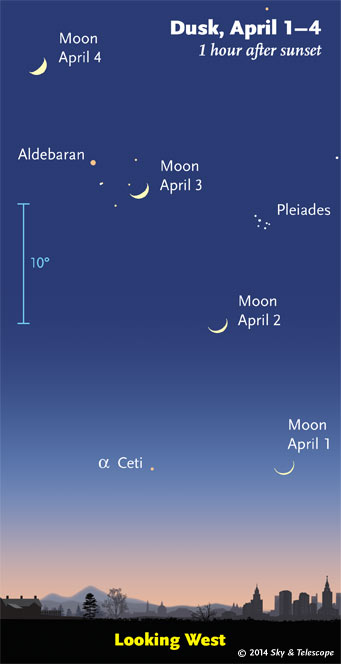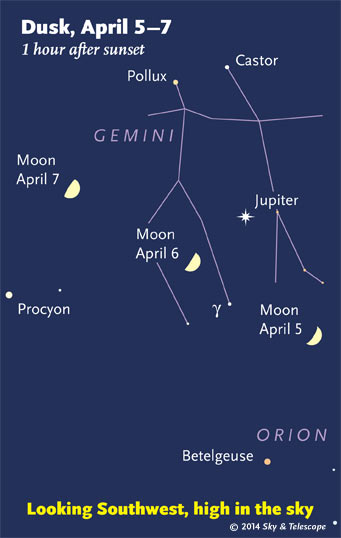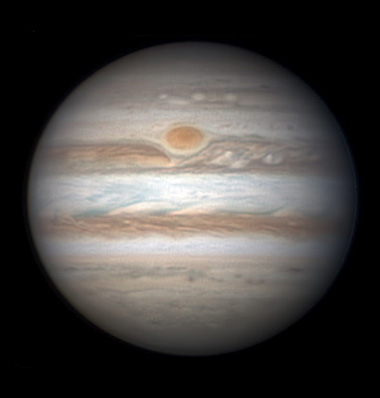
The evening crescent Moon waxes across the Hyades. These scenes are drawn for the middle of North America. European observers: move each Moon symbol a quarter of the way toward the one for the previous date. The blue 10° scale is about the size of your fist held at arm's length. For clarity, the Moon is shown three times actual size.
Friday, March 28
Saturday, March 29
Sunday, March 30
Monday, March 31
Tuesday, April 1
Wednesday, April 2
Thursday, April 3
Friday, April 4

The waxing Moon will pass under Jupiter as it reaches first quarter.
Alan MacRobert
Saturday, April 5
Want to become a better astronomer? Learn your way around the constellations. They're the key to locating everything fainter and deeper to hunt with binoculars or a telescope.
This is an outdoor nature hobby. For an easy-to-use constellation guide covering the whole evening sky, use the big monthly map in the center of each issue of Sky & Telescope, the essential guide to astronomy. Or download our free Getting Started in Astronomy booklet (which only has bimonthly maps).
Once you get a telescope, to put it to good use you'll need a detailed, large-scale sky atlas (set of charts). The standards are the little Pocket Sky Atlas, which shows stars to magnitude 7.6; the larger and deeper Sky Atlas 2000.0 (stars to magnitude 8.5); and once you know your way around, the even larger Uranometria 2000.0 (stars to magnitude 9.75). And read how to use sky charts with a telescope.
You'll also want a good deep-sky guidebook, such as Sue French's Deep-Sky Wonders collection (which includes its own charts), Sky Atlas 2000.0 Companion by Strong and Sinnott, the bigger Night Sky Observer's Guide by Kepple and Sanner, or the beloved if dated Burnham's Celestial Handbook.
This Week's Planet Roundup

Jupiter's Great Red Spot had just passed the central meridian when Christopher Go took this image on April 1st. The central meridian longitude was 214°. South is up. In the South South Temperate Belt, the trio of white ovals that formed the "Mickey Mouse hat" has moved to be almost due south of the Great Red Spot. The middle of the three hat ovals seems to be widening and fading.
Mercury is deep in the glow of sunrise.
Venus (magnitude –4.5) rises as the bright "Morning Star" just before dawn begins and moves higher as the sky lightens; look east-southeast.
Mars (magnitude –1.2, in Virgo) is nearing its April 8th opposition. It rises in twilight and dominates the southeast after dark — a fiery blaze with fainter Spica 5° or 6° to its lower right. They're highest in the south around 1 or 2 a.m. daylight-saving time.
In a telescope Mars has grown to just shy of the 15.1″ diameter it will display when passing closest by Earth in mid-April. See the telescopic Mars map and observing guide in the March Sky & Telescope, page 50. Use our Mars Profiler to find which side of the planet will be facing you.
Jupiter (magnitude –2.2, in Gemini) dominates the sky overhead in twilight (for mid-northern skywatchers). It sinks westward through the evening and sets around 2 or 3 a.m. See our articles on observing Jupiter in the January Sky & Telescope or the briefer online introduction Jupiter: Big, Bright, and Beautiful.
Saturn (magnitude +0.3, in Libra) rises around 10 or 11 p.m. and is highest in the south around 3 a.m. By then it's far left of Mars and Spica, and less far to the upper right of Antares.
Uranus and Neptune are hidden behind the glare of the Sun.
"We may be little guys, but we don’t think small. It’s the courage of questions, of grasping our true circumstances, and not pretending we are at the center of it all, that is adulthood."
— Ann Druyan, 2014
All descriptions that relate to your horizon — including the words up, down, right, and left — are written for the world's mid-northern latitudes. Descriptions that also depend on longitude (mainly Moon positions) are for North America.
Eastern Daylight Time (EDT) is Universal Time (UT, UTC, or GMT) minus 4 hours.
To be sure to get the current Sky at a Glance, bookmark this URL:
http://SkyandTelescope.com/observing/ataglance?1=1
If pictures fail to load, refresh the page. If they still fail to load, change the 1 at the end of the URL to any other character and try again.
 0
0
Comments
You must be logged in to post a comment.